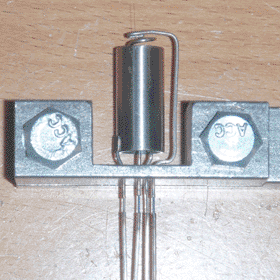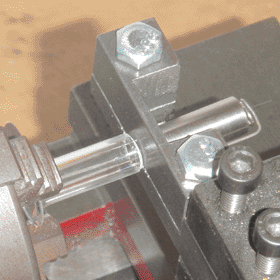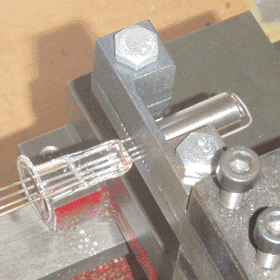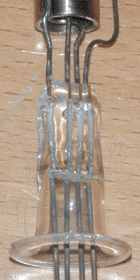



The previously made wire holder worked, but it only allowed for a short length of wire to protrude beyond the pinch seal, which then had to be spot welded to the tube internals. This produced messy tubes, as spot welding is often unpredictable. It also had poor clamping ability, as the design was based on lightly pressing the wires in place, which is difficult to do for more than two wires. To resolve these issues, I designed a guillotine-style wire holder which clamps the wires firmly by cutting into them slightly, and holds the wires from the side so that the internals of a vacuum tube can be fully completed before the pinch seal is made. This results in a very clean tube structure with few visible welds, and the close proximity of the holder to the pinch results in very accurate spacing of the feedthroughs. This allows for a maximum of five feedthroughs to be reliably fit through a 10mm pinch seal, which corresponds to the previously designed five-pin socket.
The machining for this part was somewhat complex, so I recorded it below. I started with a 4 inch length of 5/8 inch square steel bar. I then drilled and tapped two 1/4-20 holes in it for the tightening bolts and drilled eleven 1mm holes for the wires, with 0.5mm gaps between them. This allows for a maximum of 11 feedthroughs to be held, although this would require a very large pinch seal. I designed it optimistically, as in the future I plan to make larger vacuum tubes. I then milled away the excess material to turn the holes into troughs and to shorten the clamping section.




This new holder worked extremely well. The wires were held so rigidly that I was able to use them as a guide for the glass mashers, resulting in a perfectly centered pinch seal with no wires pushed out of position. One error is apparent from the above pictures, however. The glass tended to gather towards the base of the pinch seal, pulling itself away from the wire holder more than I anticipated. This resulted in some of the tungsten being exposed, and the seal length being shorter than intended. I also miscalculated the position and width of the mashers, which contributed to the mis-placement of the tungsten seals; I would have preferred them to be in the center of the pinched area. Regardless, the seal color looked good, so I used this completed assembly in my next triode.